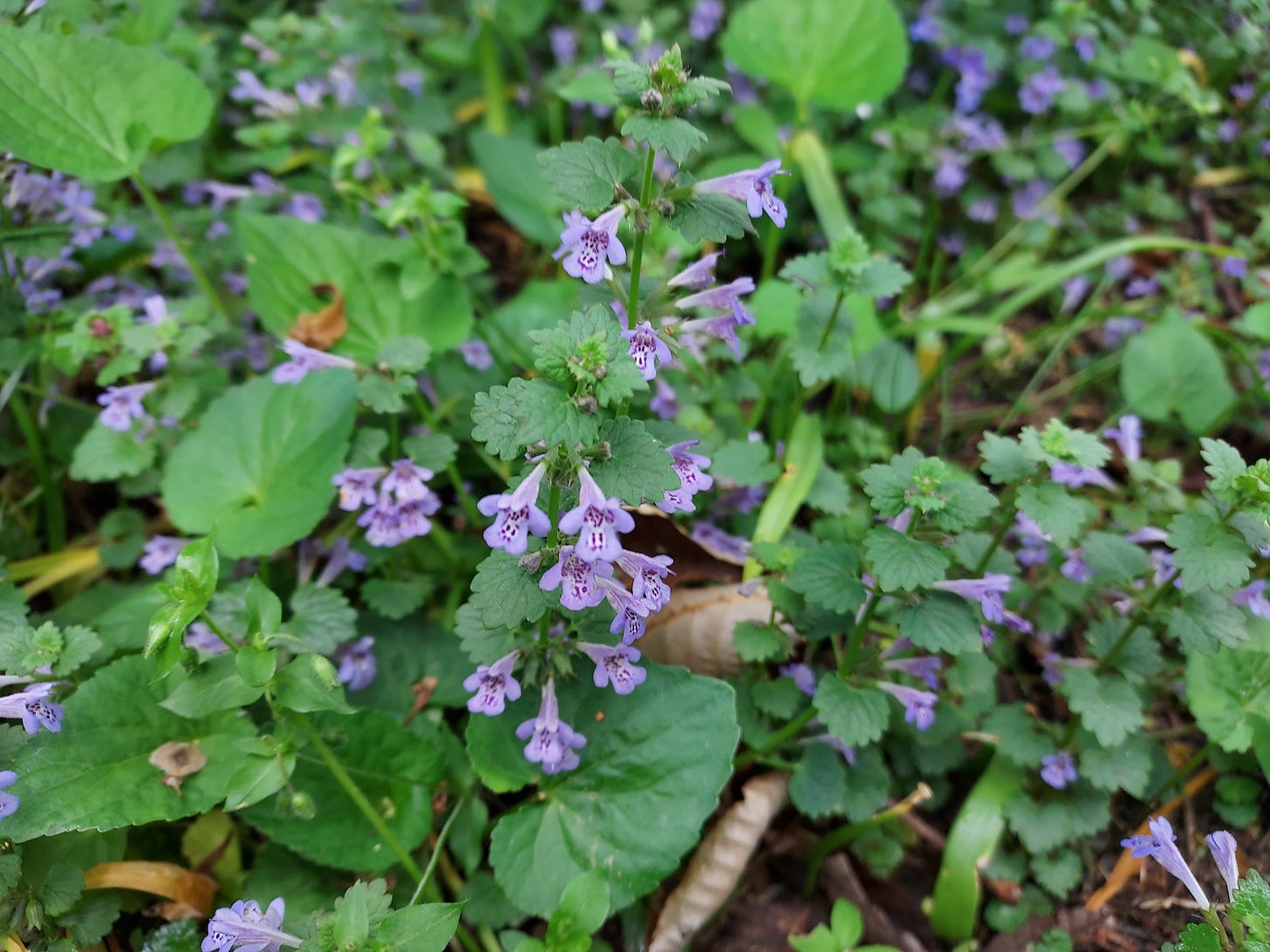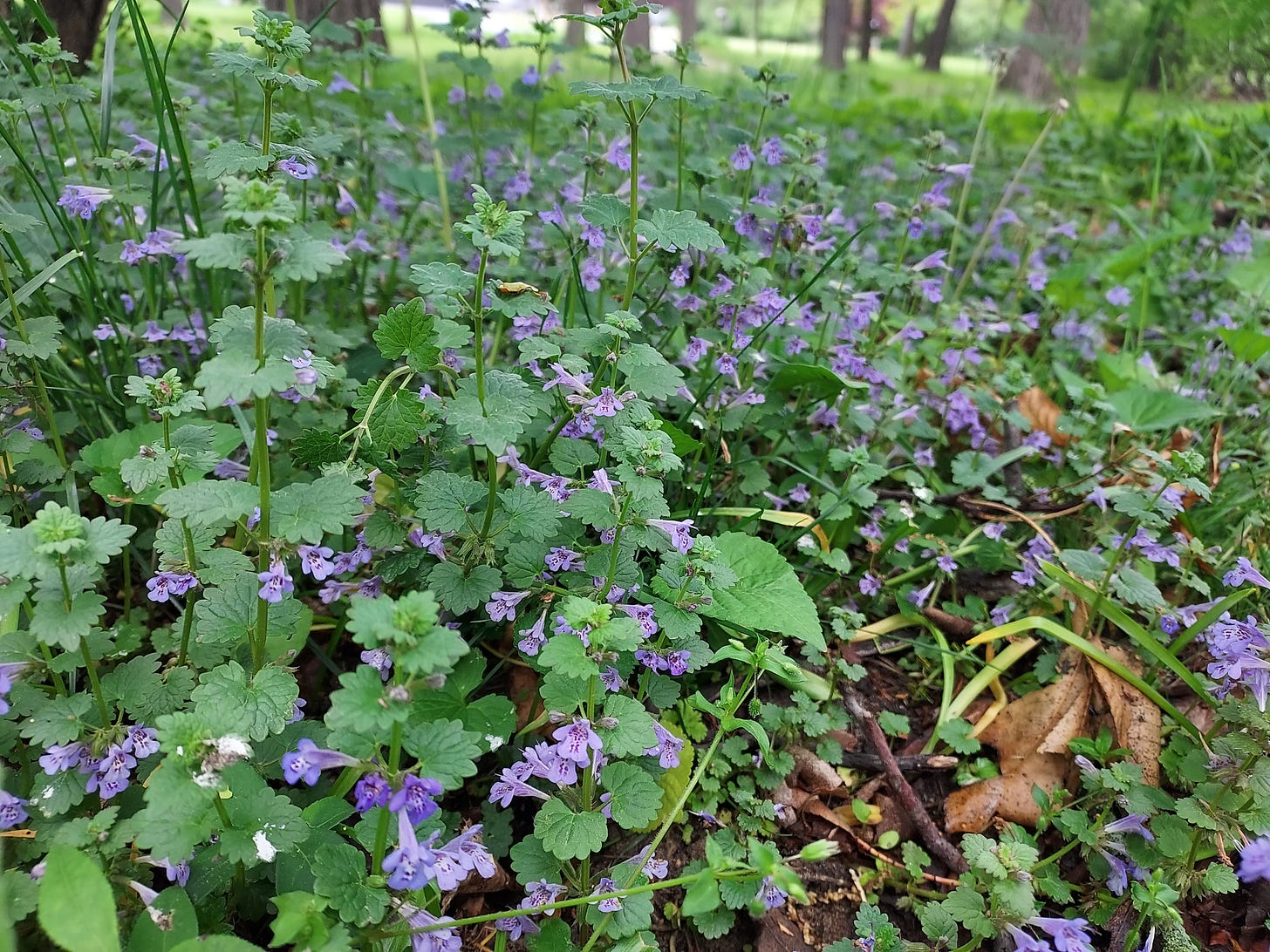Ground ivy - another medicinal garden herb turned lawn nemesis. Ditch the lawn, eat the weeds.
Creeping Charlie is another name for the minty smelling ground cover. Tiny purple edible flowers are mild in flavor. The leaves stronger but not quite mint.
Ground Ivy / Creeping Charlie leaves are minty and flavorful. A little goes a long way in a Green Goddess style blended salad dressing.

*salad with the Ground Ivy salad dressing and violets are the flowers. They have a slight peppery flavor. Romaine and dandelion greens with celery and yellow Bell pepper.
https://www.healthygreensavvy.com/creeping-charlie-uses/ That article had a salad dressing recipe link which I adapted to my pantry and diet:
Ground Ivy Salad Dressing
1/2 cup apple cider vinegar
1/2 cup extra virgin olive oil
~1/4 teaspoon salt and pepper - to taste or add at the table to taste
2-3 cloves garlic roughly chopped
1/4 cup Ground Ivy leaves
Blend/grind in a food processor until creamy and blended.
Health benefits of Ground Ivy / Creeping Charlie
Iron chelator, anti-inflammatory and used medicinally in many places as a traditional herb. It is rich in trace minerals and may preferentially uptake minerals so avoid sources that may have lead in the soil. Vanadium and chromium were present in significant amounts and ground ivy was a good source of potassium, calcium and magnesium in addition to iron.
The most common phenols found were “rutin, chlorogenic, cryptochlorogenic, caffeic and rosmarinic acid” and “apigenin and luteolin” were also found in glycolsylated form. Those include SARS-CoV-2 therapeutics.
Regarding Ground Ivy (Glechoma hederacea L.): “Results regarding nutritive analyses, conducted using standard AOAC methods, showed the abundance of samples in terms of insoluble dietary fibre, protein, calcium and potassium, while rutin, chlorogenic, cryptochlorogenic, caffeic and rosmarinic acid were the most dominant phenolic compounds. In addition, LC-MS/MS analysis revealed the presence of apigenin and luteolin in glycosylated form.” […] “Characterization of macro- and microcomposition of ground ivy samples harvested from different natural habitats is presented in Table 1 and Table 2.” (Šeremet, et al., 2022)
For a green vegetable . . . ground ivy has a significant amount of protein almost as much as grains (so not much compared to beans, nuts or seeds - or meat).
“Furthermore, all harvested samples were found to be rich in proteins, especially sample G5 which had a protein content (23.12% dw) almost in the range of grain legumes (24.0–26.1%), which are considered to be rich protein sources [29].” (Šeremet, et al., 2022)
Dandelions, Garlic mustard, and now Creeping Charlie - all valued garden herbs or vegetables in other times and places - now considered a lawn nemesis in the land of pristine grass lawns. My unkempt lawn is actually a veritable fortune in functional foods.
Currently the wild strawberries are tiny yellow flowers - tiny bits of berry delight later in the summer will be sprinkled among the violets, dandelions, creeping Charlie, plantain and occasional tuft of grass.
The strawberry flower is closed for a cold cloudy day and opens in sun showing a four or five petal daisy shape.
Ground ivy is the familiar name in areas that used it traditionally as a food/herb, and it became known as creeping Charlie in areas with lawns in mind. It can be hard to get rid of if you don’t want it. I think the purple flowers are cute and it smells minty when you walk. If it chokes out the buckthorn, that is also a win. Ground covers are useful as ‘ground cover' because they tend to dominate an area and keep down other weeds and that does seem to be true. Some areas are almost all ground ivy now shile other areas of the yard have the strawberries and a mix.
Buckthorn was never a garden herb but was sold as an ornamental shrub that makes little purplish black seeds that float and look like blueberries slightly but cause diarrhea in humans and animals. They spread along waterways and choke out any area with sun and some nutrients as they become woody shrubs or small trees in clusters and are so thick animals can’t get through. They spread by roots too and will regrow from a broken plant. Animals don’t eat the buckthorn leaves either.
Humans leave a mark often without realizing it or intending long term effects like choked out rivers and streams. I planted flowerbeds 40 years ago and the result is fragrant today but there are fewer of the original tiny woodland flowers.
Wildcrafting is a bit like gardening the wild. Encouraging the beneficials and not over-harvesting them and removing those less helpful that are taking over too much space for their value to the ecosystem as a whole.
We need to return to home grown victory gardens for improving our health victories.
Food sources of some of the phytonutrients that were mentioned:
Luteolin is a flavonoid "found in celery, thyme, green peppers, and chamomile tea," (18) and "chrysanthemum flowers, sweet bell [green/red/orange] peppers, carrots, onion leaves, broccoli, and parsley [7 8]. (21)
Apigenin is a flavonoid found in "grapefruit, plant-derived beverages and vegetables such as parsley, onions, oranges, tea, chamomile, wheat sprouts and in some seasonings." (19)
Intake of more dietary flavonoids on average was associated with a reduced cancer risk. (19)
Rutin is a flavonoid found in buckwheat, citrus fruit, figs, apples, asparagus, and green tea.
Rosmarinic acid is found in rosemary for which it is named, and other herbs.
Chlorogenic and caffeic acids are in pomegranate peel and green tea and coffee ½maybe.
Disclaimer: This information is provided for educational purposes within the guidelines of Fair Use. While I am a Registered Dietitian this information is not intended to provide individual health guidance. Please see a health professional for individual health care purposes.
Reference List
(Šeremet, et al., 2022) Šeremet D, Jokić S, Aladić K, Butorac A, Lovrić M, Tušek AJ, Obranović M, Mandura Jarić A, Vojvodić Cebin A, Carović-Stanko K, Komes D. Comprehensive Study of Traditional Plant Ground Ivy (Glechoma hederacea L.) Grown in Croatia in Terms of Nutritional and Bioactive Composition. Foods. 2022 Feb 23;11(5):658. doi: 10.3390/foods11050658. PMID: 35267291; PMCID: PMC8909519. https://www.ncbi.nlm.nih.gov/pmc/articles/PMC8909519/








JD - Not good, but excellent work. Ditch the lawn... and the round up.
That is one of the first spring edibles in NC - absolutely covers the fields along with henbit and wild mustard. WONDERFUL!